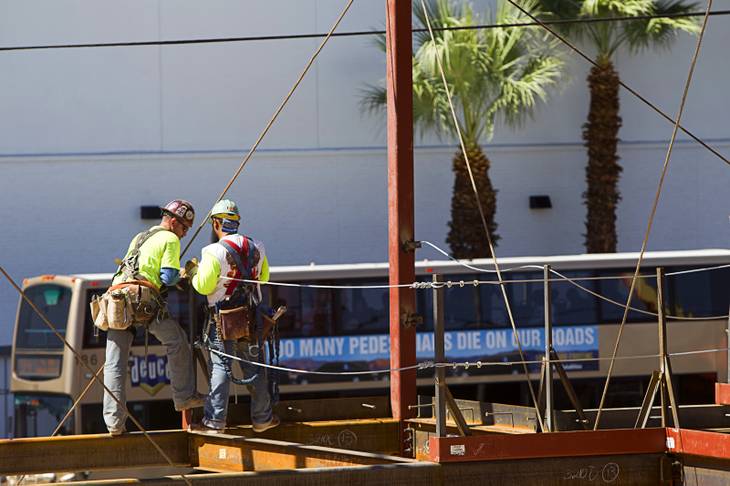From Summerlin to the Interstate 15 corridor to Henderson, abandoned building projects that were once the symbols of economic disaster in Las Vegas are back on track, becoming the most visible signs of a new beginning for the construction industry.
But resurrected projects like Downtown Summerlin, the Wyndham timeshare building near the Rio, and Vantage Lofts in Henderson aren’t the only indicators that construction is on the upswing in Nevada. Employment numbers also suggest the sector is rebounding.
“2013 was the first year we started adding jobs in the construction sector since 2006,” said Bill Anderson, chief economist for Nevada’s Department of Employment, Training and Rehabilitation.
The state has averaged 60,000 construction workers per month this year, up from 50,000 in 2013. That’s the good news. On the flipside, the monthly number was 143,000 during the height of the boom.
“We lost nearly 100,000 jobs during the recession,” Anderson said.
Mike Prascsak, a small-business owner, weathered the storm by merging his concrete company with Frazier Masonry in 2009. Prascsak said the partners concentrated on maintaining clients they already had, and that has made the difference in their success today.
During the slow years, many of Frazier’s competitors were willing to do jobs for less than Prascsak could clear in overhead. But quality suffered. So Frazier focused on meeting deadlines and keeping standards high, while working within tighter budget constraints. Maintaining those principles helped it land school and military contracts that kept the business afloat.
“There’s no room for error anymore,” Prascsak said. “The recession taught us to work smarter, and that’s something we’ve carried with us into the present.”
Today, Prascsak says work is starting to pick up locally. With such clients as the Smith Center for the Performing Arts, Nevada State College, WinCo and FedEx, Frazier has secured a steady of stream of local contracts. But raising concrete walls up to 45 feet tall and 8 inches thick is the easy part; luring skilled workers back to the area is tricky.
“We lost half of our workforce during the recession, and now the challenge is bringing them back,” Prascsak said.
Though it’s unclear just how many workers left during the recession, companies are willing to pay top dollar to get them back.
Promises of $42 per hour are being made to skilled workers for improvements on California infrastructure and new sports stadiums. And that’s good news for an industry that’s interdependent.
“It takes all of us — painters, electricians and plumbers — to get the jobs done,” Prascsak said. “When one sector grows, the others grow, too.”
But the momentum hasn’t picked up for everyone just yet. Anthony Cairncross, a 40-year-old ironworker and Las Vegas native, has been out of work since May. His last job site was at the Wyndham Grand Desert but he says his footprints are all over town. With big names like Mandalay Bay, the Stratosphere, Aliante and the Cromwell on his resume, Cairncross has more than 15 years of experience as a welder in the shifting economy.
“Everything in Nevada is boom and bust. One day you’re eating filet mignon and the next, you’re rolling pennies for gas money. It happens that fast,” he said.
Job offers are coming in from surrounding states, especially California, but Cairncross — a single father of four — will wait it out until work picks up locally. He believes his next job will materialize in the next few months, and he may be right.
Construction jobs have increased about 11-12 percent compared with a year ago, Anderson said. Nationwide, they are up between 3 and 4 percent, he said.
Anderson said the growth at the height of the boom wasn’t sustainable. What we have now may be more modest in nature, but it’s much more stable if and when there is another downturn.
